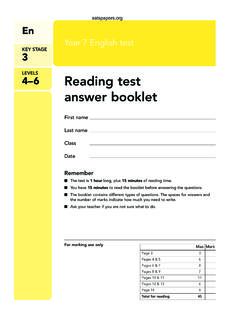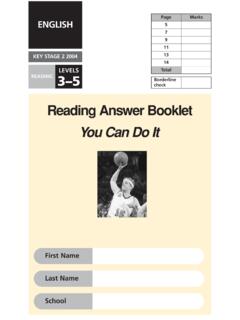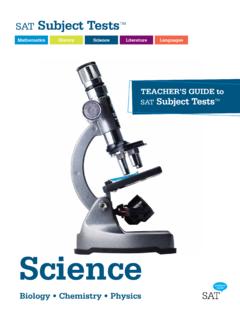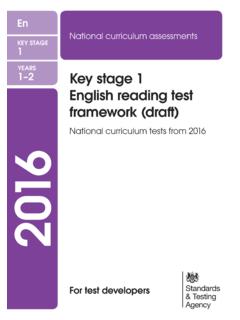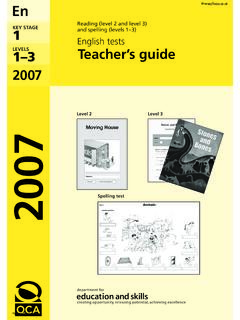Transcription of En English tests - SATs papers
1 En2003 KEY STAGE3 LEVELS4 73 KEYSTAGEKEYSTAGE3 KEYSTAGE3 KEYSTAGE2003 Mark schemeEnglish published in 2003 Qualifications and Curriculum Authority 2003 Reproduction, storage, adaptation or translation, in any form or by any means, of this publication isprohibited without prior written permission of the publisher, unless within the terms of licences issuedby the Copyright Licensing Agency. Excerpts may be reproduced for the purpose of research, privatestudy, criticism or review, or by educational institutions solely for educational purposes, withoutpermission, providing full acknowledgement is in Great Britain by the Qualifications and Curriculum Authority under the authority and superintendence of the Controller of Her Majesty s Stationery Office and Queen s Printer of Acts of Qualifications and Curriculum Authority is an exempt charity under Schedule 2 of the Charities Act and Curriculum Authority83 PiccadillyLondon W1J KS3 English test mark scheme1 ContentsIntroduction3 Reading paper.
2 In Search of Treasure4 Introduction4 Assessment focuses for the questions6 Reading paper mark scheme7 Writing paper 21 Introduction21 Writing task24 Writing paper mark scheme25 Exemplar responses28 Shakespeare paper40 Introduction40 Henry V44 Writing task44 Writing mark scheme45 Writing exemplars48 Reading task53 Reading mark scheme54 Reading exemplars55 Macbeth63 Writing task63 Writing mark scheme64 Writing exemplars67 Reading task73 Reading mark scheme74 Reading exemplars75 Twelfth Night83 Writing task83 Writing mark scheme84 Writing exemplars87 Reading task92 Reading mark scheme93 Reading KS3 English test mark KS3 English test mark schemeIntroduction 3 IntroductionThis document contains the complete set of mark schemes for the 2003 key stage 3 English papers theReading paper, Writing paper and Shakespeare paper.
3 It includes guidance on the overall structure of the mark schemes and how they should be markers of the 2003 key stage 3 tests will be trained to follow specific guidelines to ensureconsistency of marking in applying the mark 2003 separate levels will be awarded for Reading and Writing. The individual Reading and Writingmark schemes are not level-related. The Reading level will be awarded on the basis of an aggregation ofthe marks achieved on the Reading paper and the Shakespeare reading task. Pupil performance across the two elements may vary and the marking criteria are designed to recognise and reward a range ofqualities in each. Similarly, the Writing level will be awarded on the basis of an aggregation of the marksachieved on the Writing paper (longer writing task) and the writing section of the Shakespeare paper(shorter writing task), and again pupil performance across the two tasks may vary.
4 Pupils will also receivean overall English level on the basis of the aggregation of the total marks for Reading and the total marksfor decisions about the 2003 level thresholds, ie for the separate Reading and Writing levels as well as the overall level for English , will be made on the basis of a review of a wide range of statistical andqualitative evidence. Level threshold tables, showing the mark ranges for the award of different levels for Reading, Writing and English , will be published on the QCA website on 23 June paper2003 KS3 English test mark schemeReading paperReading paper: In Search of TreasureIntroductionThis paper is a test of pupils reading skills. Evidence of pupils understanding of a text, in relation to each question and the assessment focus targeted, is looked for, rather than the quality of their written Reading paper is a test of unprepared reading.
5 The test is based on a Reading booklet which includesthree texts, covering a range of genres and styles, literary and non-literary, fiction and write their answers in a Reading answer booklet, which includes a variety of questions. The formatsfor the answers vary and include tables, short answers and continuous writing. The number of marksallocated to each question varies between 1 and 5. All pupils within the target range for the test shouldbe able to access the questions, but not all questions are of equal difficulty. A 1-mark question is notnecessarily an easy focusesEach question has an assessment focus which indicates the aspect of reading being assessed. This focuswill help to inform the judgements markers make as they mark scripts. The assessment focuses used in thispaper assess pupils ability to:AF2 understand, describe, select or retrieve information, events or ideas from texts and use quotationand reference to text;AF3 deduce, infer or interpret information, events or ideas from texts;AF4 identify and comment on the structure and organisation of texts, including grammatical and literaryfeatures at text level;AF5 explain and comment on writers uses of language, including grammatical and literary features atword and sentence level.
6 AF6 identify and comment on writers purposes and viewpoints and the overall effect of the text onthe ,use a range of strategies, including accurate decoding of text, to read for meaning and AF7, relatetexts to their social, cultural and historical contexts and literary traditionare not covered in this KS3 English test mark schemeReading paper 5 Reading paperMark schemeLow-tariff questionsFor low-tariff questions (worth 1 to 3 marks), there is a marking key, which indicates the correct answersfor each question and how marks should be awarded. Although this is designed to be comprehensive,there will be occasions when markers need to use their professional judgement as to whether a particularresponse matches one of the specified answers in the marking key. In such cases, markers will checkwhether what a pupil has written: answers the question; meets the assessment focus for the which say something sensible about the text but do not answer the question set, or are based onparts of the text which are outside the specified section, will not be rewarded.
7 Similarly, generic answerswhich do not relate to the specific text in question will gain no some questions, pupils are required to give textual evidence to support their answers. It is expectedthat pupils will give quotations but they should not be penalised if they do not use quotation marks or ifthey make a small slip in copying out. In some cases, quotations may be embedded in pupils answerswhich is also questions have designated spaces for different parts of an answer. The principles for awarding marksvary slightly, depending on the nature of the space provided, as indicated in the table 3, 9, 12pupils can only gain credit if an answer is writtenin the appropriate ) and b) part questionsQuestions 2, 4, 8pupils answers to a) or b) can only be credited if they are written in the appropriate space.
8 An answer placed in the space for a) which iswrong for a) but correct for b) cannot pointsQuestions 1, 2a, 5 where more than one bullet is given to indicate theand 11number of points to be made, answers can becredited if they fulfil the requirements of themarking key even if the points appear together after the same bullet. In the marking key for low-tariff questions quotations from texts are given in italics. In addition, thefollowing symbols are used:/alternative possible answers which are substantively the same( )parts of answers which pupils do not need to give to gain the mark specific/required answers examples of acceptable answers5-mark questionsFor 5-mark questions, a set of criteria is provided in three bands which describe the quality of answersexpected. Marks should be awarded according to the criteria using the accompanying sample answers toconfirm judgements.
9 Responses which do not fulfil enough of the criteria for 1 mark should be awarded 0. paper2003 KS3 English test mark schemeReading paperIn Search of TreasureAssessment focuses for the questionsAF2AF3AF4AF5AF6122a12b1324252 Total322211061718293105 Total0452112112123135 Total0025310 Total3699532understand,describe, selector retrieveinformation,events or ideasfrom texts and usequotation andreference to textdeduce, inferor interpretinformation,events or ideasfrom textsidentify andcomment on thestructure andorganisation oftexts, includinggrammatical andliterary featuresat text levelexplain andcomment onwriters uses of language,includinggrammatical andliterary featuresat word andsentence levelidentify andcomment onwriters purposesand viewpointsand the overalleffect of the texton the readerTreasure-huntingTreasureIslandInto theTomb KS3 English test mark schemeReading paper 7 Reading paperReading paper mark schemeQuestions 1 5 are about Treasure-hunting(page 3 in the Reading booklet) to paragraph 1, what two desires motivate the majority of treasure-hunters?
10 (up to 2 marks)AF2: understand, describe, select or retrieve information, events or ideas from texts and usequotation and reference to textAward 1 markeach for either of the following points, up to a maximum of 2 marks: (the desire)to get rich quick / the fulfilment of dreams; (the desire for) )From paragraph 2, give two examples of historical events or stories that are mentioned.(1 mark)AF2: understand, describe, select or retrieve information, events or ideas from texts and usequotation and reference to textAward 1 markforany twoof the following events or stories: (the burial chambers of)Tutankhamun; Shi Huangdi(buried with models of his army) / Chinese emperor buried with models of his army; (the eruption of)Vesuvius / Pompeii; (the sinking of) the not acceptthe phrase burial chamberson its paper2003 KS3 English test mark schemeReading paperb)Suggest one reason why the writer included a rangeof examples to support her ideas in paragraph 2.







